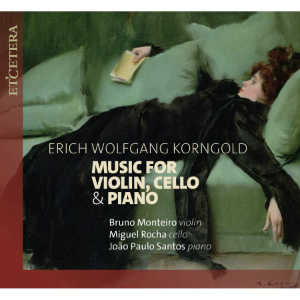
Erich Wolfgang Korngold (1897-1957)
Music For Violin, Cello & Piano
Piano Trio Op. 1 (1909-1910)
Violin Sonata Op. 6 (1912-13)
Tanzlied des Pierrot from Die Tote Stadt Op. 12 (1920, arr. composer for cello and piano)
Bruno Monteiro (violin), Miguel Rocha (cello), João Paulo Santos (piano)
rec. 2023, Auditório Caixa Geral de Depósitos, ISEG Lisbon, Portugal
Et’cetera KTC1774 [72]
These are Korngold’s two earliest chamber works, written at the ages of, respectively, thirteen and sixteen, though even before his first official Op. 1 he had had a ballet, Der Schneeman, performed in Vienna and Artur Schnabel had taken his second (not his first) piano sonata into his repertory. By the time of the piano trio, he was working on his first opera, Der Ring des Polykrates, which was to have its premiere at Munich, conducted by Bruno Walter. He truly was a prodigy of practically Mozartean gifts, and no allowances need be made for the two main works here on the grounds of the youth of their composer.
They are both substantial works, each in four movements. The trio begins with a soaring line on the violin, which for me anticipated that at the beginning of Korngold’s violin concerto, one of his last and best works. There are flurries on the piano and the cello comes into its own a little later. The idiom is a late romantic one, which would not have disturbed Brahms, though there are occasionally moves in the direction of expressionism, though not actually getting there. The second movement is a Scherzo featuring an angular and playful theme on the piano – wide leaps are characteristic of Korngold’s music at this period. These also occur in the slow movement, while the finale starts with a fugato before settling down to something more like a rondo.
I found the trio, though accomplished, somewhat unremittingly intense, and the violin sonata has more light and shade. It is, however, on a similar model to the trio. Korngold had rarely given prominence to the cello in the trio, so it is not surprising that he dropped the instrument entirely in his next chamber work. Again we have a soaring violin line at the opening, this time high into the stratosphere, with very full and rich writing for the piano. The Scherzo features a wide-ranging theme which goes through all sorts of tricks and modifications against a sometimes thunderous piano part. The slow movement is dreamy, with constant modulation and a sweetness suggesting Richard Strauss and with highly chromatic writing for the piano. The finale is a set of variations and brings the work to a quiet close.
As an encore we have a transcription from the opera Die Tote Stadt, Korngold’s greatest success in his lifetime, and which, after decades of neglect, is again getting performed and recorded. This is a charming salon piece.
These performances are by a Portuguese team who are accomplished chamber players and they play with a will, giving full-blooded and enthusiastic performances of what are technically very taxing works. The recording is good, and the booklet note, by the violinist here, Bruno Monteiro, helpful. There is no need to suggest that these works deserve to join the repertory – they already have, with numerous recordings available of each. However, these tend not to be coupled together, so anyone who would like this very convenient coupling should be well pleased with this.
Stephen Barber
Help us financially by purchasing from




















